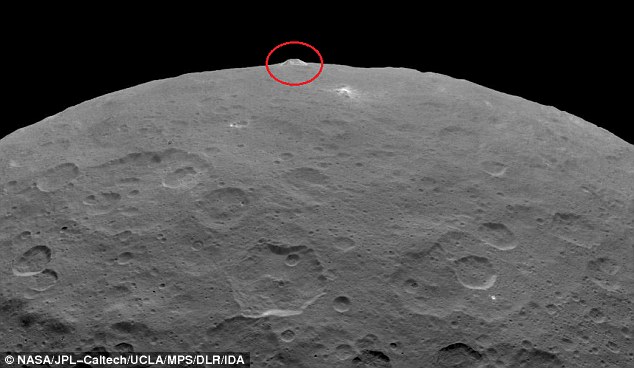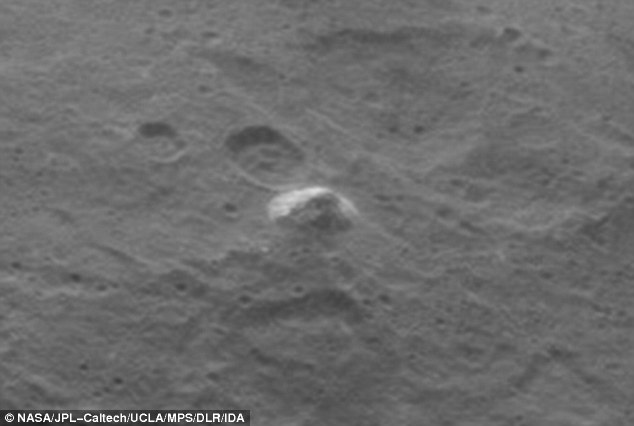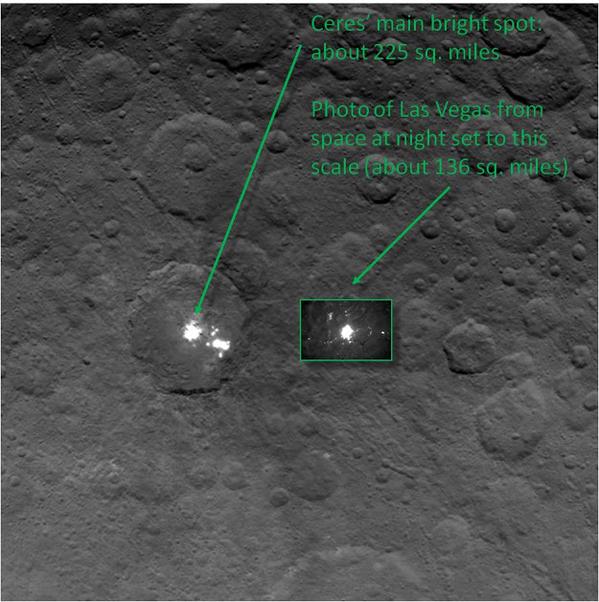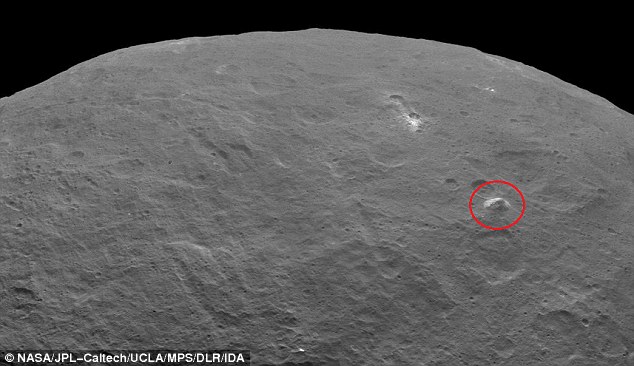
|
|||
3-Mile-High 'Pyramid' and Bright Light On Ceres - Unexplained Mysteries
Source : http://www.dailymail.co.uk
New images of Ceres are the clearest ever taken, but NASA's scientists still haven't figured out the enigmatic dwarf planet. The agency's latest photos of Ceres show multiple bright spots — and a "pyramid-shaped peak towering over a relatively flat landscape." That's according to an update posted by the space agency, saying that Ceres and its bright spots "continue to mystify." The latest images of Ceres taken by the Dawn spacecraft have captured a fascinating pyramid-shaped mountain on the surface. As the spacecraft gets closer, more and more features are beginning to reveal themselves.This includes the mysterious bright spots, which appear now as an array of dots scattered across the floor of a crater - but their source remains unknown. Ceres has long been a bit of a mystery, but it began mystifying NASA in earnest earlier this year, when images arrived that showed two unmistakably bright spots in a large crater on the dwarf planet's surface. The view captured by the Dawn spacecraft this month "shows even more small spots in the crater than were previously visible," NASA says, providing the latest revelations about a dwarf planet that the agency has said "has more in common with Earth and Mars than its rocky neighbors." According to NASA: "At least eight spots can be seen next to the largest bright area, which scientists think is approximately 6 miles (9 kilometers) wide. A highly reflective material is responsible for these spots — ice and salt are leading possibilities, but scientists are considering other options, too." 
For now, scientists must make do with these tantalising glimpses of the features that are waiting on the surface. In one new image, a pyramid-shaped peak is seen towering over a relatively flat surface. The mountain is peculiar, as there are a few other features like it in the surrounding region - or even the rest of the dwarf planet. THE MYSTERIOUS WORLD OF CERES Ceres is 590 miles (950 km) across and was discovered in 1801. It is the closest dwarf planet to the sun and is located in the asteroid belt, making it the only dwarf planet in the inner solar system. Ceres is the smallest of the bodies currently classified as a 'dwarf planet'. It lies less than three times as far as Earth from the sun - close enough to feel the warmth of the star, allowing ice to melt and reform. Nasa's Dawn spacecraft made its way to Ceres after leaving the asteroid Vesta in 2012. There is high interest in the mission because Ceres is seen as being a record of the early solar system, and may also have shifting ice on its surface. The structure is thought to rise about three miles (five km), which is roughly the height of Mont Blanc in France and Italy, the highest mountain in the Alps. Another image reveals the bright spots in greater detail. Several can be seen next to the largest bright area, estimated to be six miles (9km) wide.  Ice and salt are the leading theories for what is causing this odd reflectivity. ‘It is exciting seeing these features come into sharper focus,’ Dr Marc Rayman, Dawn’s mission director and chief engineer. ‘A few months ago, when Dawn began observing its new home from afar, we called it a bright spot. As the explorer closed in and provided better views, we realised it was two bright spots. ‘Now we see it is many. It’s still not clear what is causing these strong reflections, and I think still more data are needed. ‘Everyone has her or his own personal favorite theory, but the ultimate arbiter is nature. That is, we can all speculate, and we can offer arguments, but the answer is going to be clear soon. ‘My money is on the remnants from ice that has sublimated. The salts left behind then could be what’s reflecting the light.’ To be fair, the agency offered no suggestion that the towering structure is an offering to some long-lost space emperor or home to our new alien overlords. And, to be even more fair, it's probably just a really tall mountain in a solar system filled with wondrous and strange natural phenomena. But the Dawn mission has done nothing but stoke imaginations since the discovery of mysterious bright spots on the surface of the dwarf planet in February and the beginning of the probe's orbit in March. Folks have claimed to have spotted giant alien motherships hovering over the planet, bat-winged spaceships parked on its surface and even evidence of alien cities.  Several theories are currently being touted for what the mysterious bright white spots are on Ceres. The Hubble Space Telescope has found more than 10 on the surface, but Ceres has found that the two most prominent - ‘spot 5’ - are in a crater about 57 miles (92km) wide. One theory is that they are salt flats that are reflecting sunlight, left on the surface by saltwater or by other chemical reactions. Another theory is that they are regions of ice, again reflecting sunlight. Ceres is thought to have plenty of ice beneath its surface, which could be exposed when a asteroid or comet strikes the surface. The fact these bright spots are in a crater - where such an impact occurred - supports this theory. Another possibility is that they are cryovolcanoes - volcanoes that are shooting out water or ice. However, the lack of a raised area around the spots consistent with a volcano suggests this might not be correct. And they could even be water vapour ejecting from a liquid reservoir under the ground, although again current observations - namely a lack of additional material near the spots - suggests this is not the case. comments powered by Disqus Submit News/Videos/Links | Discuss article | Article Link More Unsolved and Unexplained Mysteries |
More can be addded on request. Direct your requests at vinit@theunexplainedmysteries.com
